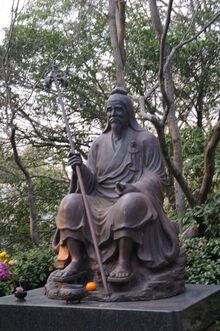
Iga province is on narrow and steep mountain paths, making it difficult to ride horses. Especially for large units, it is difficult to fight there. Speaking for the shinobi who knew the land and it's geography well, the complications of the land was preferred. There many areas to hide in like behind and atop of trees. They could observe the movement of troops carefully without being noticed.
In Iga, there were 12 leaders who decided the standpoint and rules of their organization through popular vote. This was done to avoid power from being concentrated on one person.
The Iga and Koka jizamurai families/clans often cooperated with each other, performed missions together and exchanged information. Although the Iga's traditions did not include a lot of ritual magic like the Koka's traditions.
History[]
Origins[]

A statue of Enno-Ozunu
There are three theories as to who the ancestors of the Iga-mono were. Shugendo (修験道) ascetics (Yamabushi 山伏), people from overseas who transmitted iron-making to Japan in ancient times and bandits.
Legend has it that the founder of Shugendo was Enno-Ozunu (役 小角). Ozunu's life and character is filled with folklore. In accordance with traditions, he mastered various miracle-working powers as a result of many rigid ascetic practices. For instance, he could exploit even fierce gods as his servants, and he had the ability of Teleportation. In Iga, no less than one hundred statues of Ozunu have been worshiped, even today. Additionally, the legendary training places of Yamabushi and shinobi coincide with each other.
Middle Ages[]
In the middle ages of Japan, the system of government was not well established and both rulers and the ruled often shifted and social statuses were not fixed rigidly. During that age in Japan, it was not unusual that religious organizations had military power. Groups that tried to reject the pressure from their governors appeared. They were called Akutou (悪党). In Iga, the Akutou resisted Todaiji, the government of Iga, by means of disturbing the payment of land tax to Todaiji by force of arms. The battles between Todaiji and Akutou in Iga continued no less than one hundred years, and Todaiji went into ruin. As a result of this, Iga became the domain ruled by as many as 500 lords. The Akutou are the direct archetype of shinobi groups. They used tactics which could be described as guerrilla warfare.
The intentions of each lord wad never unchanging. In the very narrow area of Iga, there were at least 500 lords, and all of them hoped to rule Iga only by themselves. If the inside of Iga was more unstable politically, it would be more likely that they would be conquered by outside enemies. Therefore the lords of Iga could not help but live together while bearing a level of dissatisfaction. Thus, with a strong tension, Iga had kept its independence and peace. Among each lord, a uniform command was established for the protection of Iga. In the territory of Iga, 12 members of a committee were chosen, and main problems were decided by the consultation of the 12 members through popular vote.
Tensho Iga War[]

Tensho-Iga War Woodblock Print
In 1579, the Tensho Iga war (天正伊賀の乱) took place. Kitabatake, Nobukatsu (北畠信雄) who was the son of the greatest Daimyo Oda Nobunaga (織田信長) invaded Iga on his own judgement for his own ambitions. But Nobukatsu was driven back by guerrilla attacks by the Iga samurai. Nobunaga raged at the result and he gave 40,000 soldiers and competent military commanders to Nobukatsu to destroy Iga. In 1581, Nobukatsu tried to defeat Iga again with 40,000 soldiers and he succeeded this time. Because the total population of Iga was as small as 100,000 including old men, children and women, Iga was overwhelmed by the large volume human wave tactics. Herewith, Iga fell under the domination of Nobunaga and Iga-mono were dispersed all over Japan. Some of the lucky shinobi and their descendants could be engaged in jobs as shinobi under Daimyos even after the Edo-period. Their jobs were as bodyguards of noble people and watchdogs of other countries, and their social status became lower Samurais. Thereby after the Edo-period, the warriors of Iga lost many opportunities they had to use shinobi no jutsu to make money.